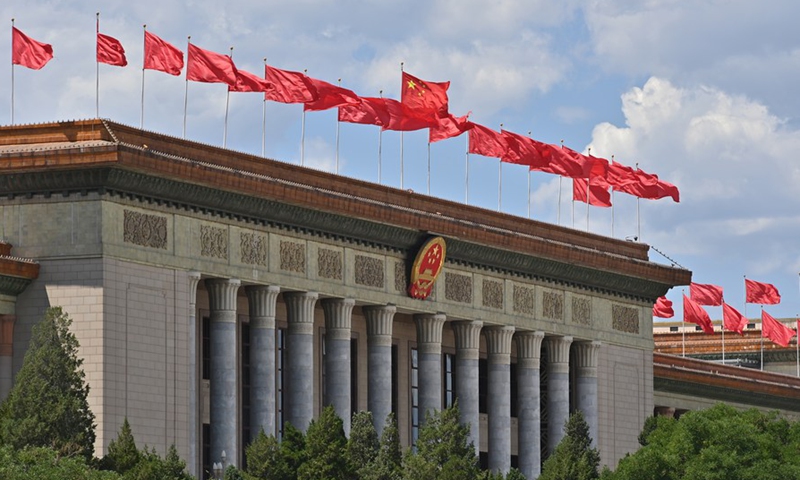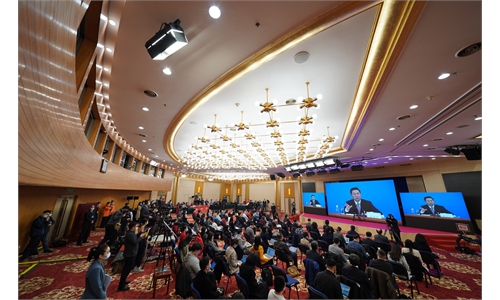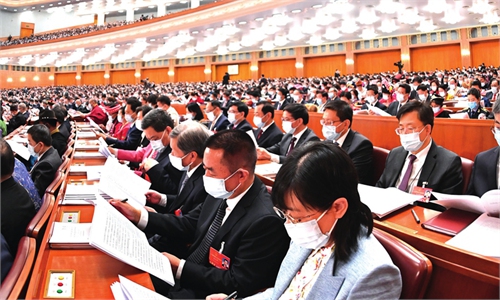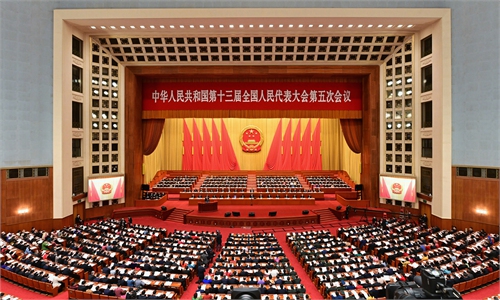
Two Sessions Photo:Xinhua
The top priority of China's economic policy this year should be aimed at promoting a steady and healthy growth. To achieve the much-hoped high-quality growth, the country should not focus on nominal GDP growth alone, but also ought to think in the long term, in order to enhance the country's core competency among the world's major economies.
As national lawmakers and political advisors are gathering for the "two sessions" to deliberate over key issues concerning China's economic and social life, the whole world once again has shifted eyes to China for inspiration to tackle challenges and make the global village a better place.
Global markets took notice when the central government's work report to the NPC (National People's Congress) announced 5.5 percent GDP as the target for 2022. After four decades of high growth rates averaging 8 percent per year, the world has become dependent upon China as the global economic driver.
Now, the world is still struggling in the deep water of an erratic pandemic and sluggish economic recovery. China's key development blueprints and initiatives will, at this juncture, should offer the world fresh impetus as well as renewed confidence.
In 2010, China overtook Japan as the second-largest economy, and surpassed the US as the world's largest manufacturing country. However, since then, China's growth has slowed down because of its exceptionally large economy.
To sustain economic growth, a country needs to continuously increase investment and production. While new technology generally comes with new capital, it is necessary to increase investment in basic and core industries in order to boost high-quality economic growth.
Opportunities brought about by China's massive development over the past years and its huge and dynamic market will continue to play the booster role for the global economy. Despite facing multiple headwinds last year, China strove to notch an 8.1-percent economic growth in 2021, demonstrating enormous vitality and resilience.
In 2022, China needs to ramp up capital investment. For an example, to meet the goal of reducing carbon emissions in line with the Paris Climate Agreement, the world needs to invest $131 trillion from 2021 to 2050. And to ensure its carbon emissions peak before 2030 and realize carbon neutrality before 2060, China needs to invest at least 255 trillion yuan ($40.39 trillion) by 2050.
And, in addition to boosting its GDP growth, China should also take other factors into consideration when making macro policies to develop new economic growth drivers, build up an ecological civilization and realize carbon neutrality, and help the country's 150 million market entities, including small and medium-sized enterprises and the self-employed, to cope with slow-down challenges.
Emphasis on "new infrastructure and manufacturing" will have an overarching focus on refitting green energy systems to replace old fossil fuel ones, together with a shift of infrastructure development from the coastal regions into the interior provinces where standards of living and job opportunity will be increased encouraging people to stay closer to home rather than migrating for opportunity.
China's foreign direct investment will remain robust in 2022, as its large domestic market and strong manufacturing base continue to attract foreign investors, particularly in wealth management, new energy, and high technology sectors.
And, facing a depressed world economy, China is committed to promoting common development. On top of a series of growth-driving measures, the Belt and Road Initiative (BRI) has become the world's broadest-based and largest platform for international cooperation.
Over the past many years, China has evolved its own system of a carefully managed market involving a combined use of both market rules and planning tools. In earlier decades emphasis was on high growth with hyper development and in turn labor and infrastructure settled in coastal cities. Now the emphasis is on re-alignment to achieve re-balance. Both planning and market in tandem are required to achieve balanced development in China.
As the coronavirus pandemic has inhibited global poverty alleviation efforts, Chinese government has put forward the Global Development Initiative with a view to building global synergy on accelerating the implementation of the 2030 Agenda for Sustainable Development, so that no country or individual will be left behind. Upholding true multilateralism, China is also actively participating in reforming the global governance system so as to make globalization more open, inclusive, balanced and beneficial for all people.
The author is an editor with the Global Times. bizopinion@globaltimes.com.cn



